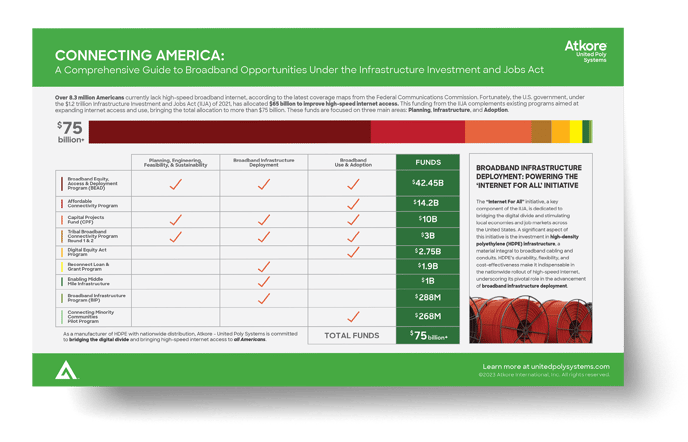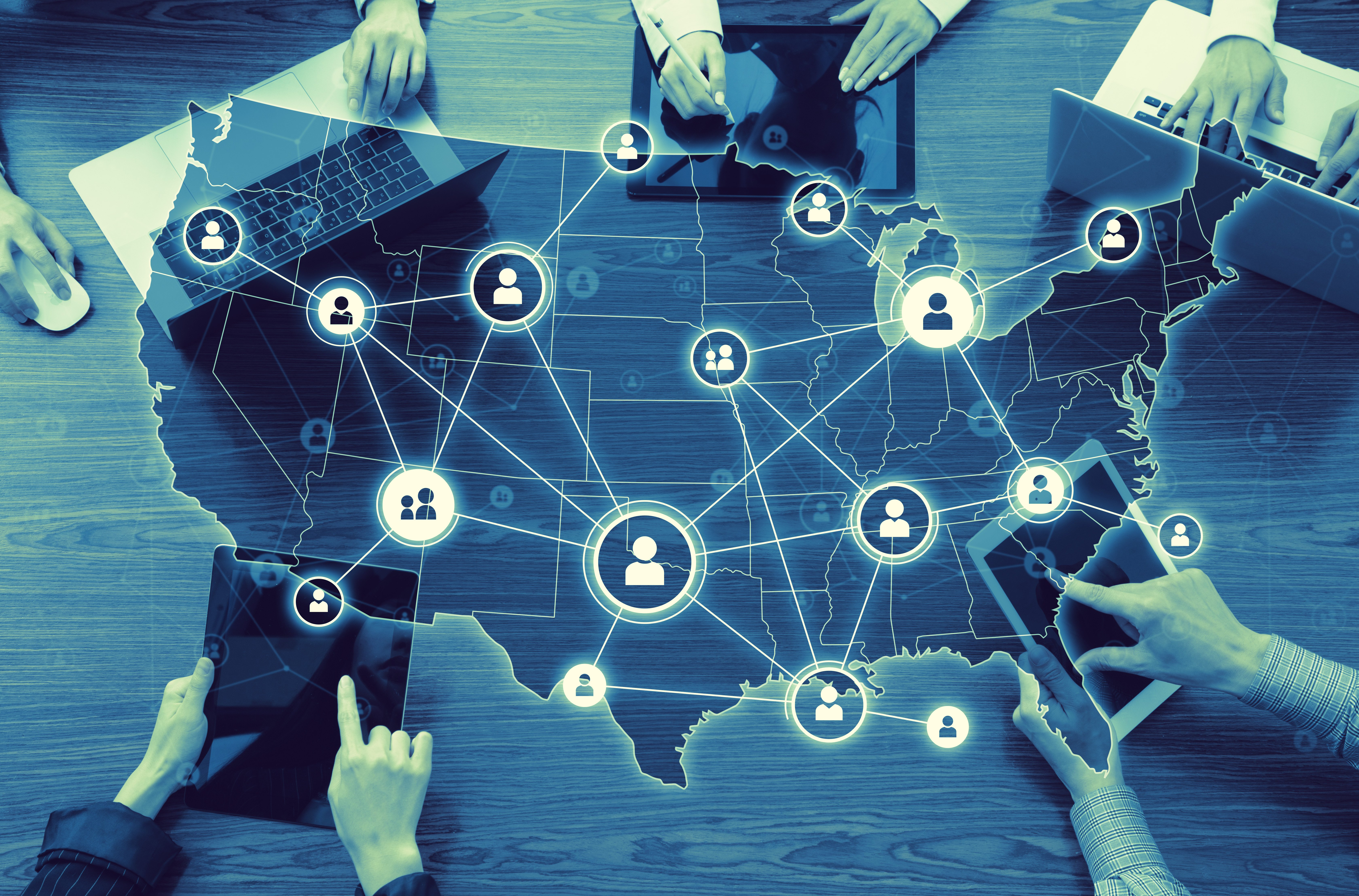The Biden-Harris Administration’s “Internet for All” initiative, fueled by the $45 billion investment from the Bipartisan Infrastructure Law, marks a significant leap toward bridging the digital divide in America. This ambitious program aims to provide every American with affordable, reliable, high-speed internet—a necessity for modern life.
As we step into 2024, “Internet for All” has reached a defining moment. This year is a reflection of the solid foundation laid in 2023, one that promises to drive an expansion of high-speed internet access throughout the United States. The focus now shifts from planning to execution, with the promise of bringing broadband connectivity to communities nationwide.
Dive into the expansive world of broadband infrastructure with Atkore’s “Connecting America” infographic. This comprehensive guide offers insights into the opportunities emerging from the Infrastructure Investment and Jobs Act.
Milestones of the BEAD Program in 2023
The year 2023 marked a significant phase in the journey of the “Internet for All” initiative, notably under the guidance of the Broadband Equity, Access, and Deployment (BEAD) program. With a substantial budget of $42.5 billion, the BEAD program focuses on expanding high-speed internet access and use.
A part of the U.S. Department of Commerce, the National Telecommunications and Information Administration (NTIA) oversees the BEAD program and, last year, actively provided detailed guidance. In April 2023, the NTIA released guidelines to streamline the “challenge process,” which is a period used to confirm locations eligible for BEAD funding. This effort was important in addressing the intricacies of the Federal Communications Commission’s (FCC) national broadband map that determines the equitable distribution of BEAD funding across the U.S.
Distribution of BEAD Allocations
The FCC’s broadband map played an integral role in the allocation process of the BEAD program. This map, published in May 2023, led to a diverse distribution of funds across states and territories.
Major states like Texas, California, Missouri, Michigan, and North Carolina were top beneficiaries, receiving substantial funding. In contrast, states with smaller geographic footprints, such as Connecticut, Delaware, Massachusetts, and Vermont, were allocated smaller amounts.
BEAD Funding: Top 5 States
| State | Amount | Unserved Locations |
| Texas | $3.3 Billion | 779,378 |
| California | $1.9 Billion | 306,910 |
| Missouri | $1.7 Billion | 337,484 |
| Michigan | $1.6 Billion | 368,390 |
| California | $1.5 Billion | 376,039 |
This distribution also extended to U.S. territories, including American Samoa and Guam. A notable point of interest is Alaska’s significant per capita allocation, underscoring the program’s focus on addressing both geographical and demographic factors in broadband deployment.
The BEAD program’s allocation of funds drew attention for its disparities and challenges, as noted by industry experts. Some regions, particularly certain U.S. territories, received notable subsidies, raising questions about the distribution’s alignment with existing broadband infrastructure levels. This scenario brought to light the broader objective of the BEAD initiative, which aimed not only to expand broadband access but also to provide a fair and equitable distribution of resources.
Navigating BABA and Other Challenges
Along with BEAD funding comes certain requirements, such as the Build America, Buy America Act (BABA), which requires that fiber networks funded through BEAD predominantly utilize American-made components. This stipulation elicited a significant response from the industry, with major companies announcing expansions in their U.S. manufacturing capabilities to align with these requirements.
Addressing industry challenges in sourcing certain components domestically to comply with BABA, the NTIA proposed specific waivers for BEAD recipients in August 2023. However, these waivers did not include all components, indicating a selective approach.
In a further development, the NTIA introduced a waiver in November 2023 for the BEAD’s letter of credit (LOC) requirement. Originally, this requirement had presented a hurdle for community-focused providers and smaller internet service providers (ISPs). The waiver provided alternatives to the LOC, enabling broader participation in the BEAD program and reflecting an understanding of the diverse financial capabilities of potential participants.
2024: A Year of Action for BEAD
As 2024 unfolds, it stands as an important year for the BEAD program. A noteworthy milestone has been the submission of initial proposals by all 56 states and territories by the December 2023 deadline. This level of participation marks a significant step in the collective effort to bridge the digital divide across the United States.
The approval process for these proposals is already underway, with several states having their first volume approved by the NTIA. These proposals, comprising two volumes, detail the approach each state will take in managing the challenge process, identifying areas in need, and setting long-term goals for digital inclusivity.
Early BEAD Trailblazers
Louisiana emerges as a front-runner, being the first state to have both volumes approved and gaining access to its $1.3 billion in BEAD funding. The proactive approach of Louisiana in 2023 has paved the way for the initiation of grant rounds and construction efforts in 2024. Other states like Colorado, Kansas, and Virginia have also made significant strides, with the first volume of their proposals receiving approval.
Colorado, in particular, is preparing for the challenge process, with a robust plan to connect 99% of its households to high-speed internet. The state anticipates early approval for its Volume II proposal and aims to finalize BEAD-eligible locations by April 2024, with the subgrantee process for its $826.5 million in BEAD funding set to open later in the year.
As we move deeper into 2024, the BEAD program will begin transitioning from planning to action. The unanimous submission of proposals and the commencement of approvals reflect a nationwide commitment to boosting broadband access. The NTIA’s role in guiding this process and the proactive steps taken by states like Louisiana and Colorado pave the way for a year of progress in the expansion of broadband infrastructure across the country.
The Promising Horizon of “Internet for All”
Looking forward, it’s clear that the “Internet for All” initiative stands on the cusp of a transformative era. The groundwork laid in 2023 has provided a robust foundation for what is poised to be a landmark year for broadband in 2024. This year is not just about continuing the momentum but about turning these ambitious plans into reality with construction efforts that will reshape the broadband landscape of the United States.
At the heart of this initiative is the deployment of critical infrastructure, notably fiber optics and High-Density Polyethylene (HDPE) conduit, which are vital for creating a resilient, high-speed broadband network. Atkore - United Poly Systems is at the forefront of building this infrastructure, providing HDPE conduit solutions made in the U.S. that are necessary for these broadband projects.
As we navigate through this transformational period in expanding broadband access, staying informed is key. To learn more about broadband funding and opportunities, download our Connecting America infographic that offers valuable insights about bridging the digital divide under the Infrastructure Investment and Jobs Act.


